Preferred temperature (Ref.
115969): 16 - 28.4, mean 25.4 (based on 3272 cells).
Phylogenetic diversity index (Ref.
82804): PD
50 = 1.0005 [Uniqueness, from 0.5 = low to 2.0 = high].
Bayesian length-weight: a=0.00447 (0.00209 - 0.00953), b=3.13 (2.93 - 3.33), in cm Total Length, based on LWR estimates for this species & (Sub)family-body (Ref.
93245).
Nível Trófico (Ref.
69278): 4.5 ±0.4 se; based on diet studies.
Resiliência (Ref.
120179): Médio, tempo mínimo de duplicação da população 1,4 - 4,4 anos (K=0.47(?); Fec=67 million; assuming tm>2).
Prior r = 0.56, 95% CL = 0.37 - 0.84, Based on 2 stock assessments.
Fishing Vulnerability (Ref.
59153): Very high vulnerability (78 of 100).
Climate Vulnerability (Ref.
125649): Very high vulnerability (76 of 100).
